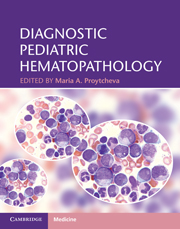Book contents
- Frontmatter
- Contents
- List of contributors
- Acknowledgements
- Introduction
- Section 1 General and non-neoplastic hematopathology
- Section 2 Neoplastic hematopathology
- 10 Chromosome abnormalities of hematologic malignancies
- 11 Expression profiling in pediatric acute leukemias
- 12 Myeloproliferative neoplasms
- 13 Myelodysplastic/myeloproliferative neoplasms
- 14 Myelodysplastic syndromes and therapy-related myeloid neoplasms
- 15 Acute myeloid leukemia and related precursor neoplasms
- 16 Hematologic abnormalities in individuals with Down syndrome
- 17 Precursor lymphoid neoplasms
- 18 Advances in prognostication and treatment of pediatric acute leukemia
- 19 The effect of chemotherapy, detection of minimal residual disease, and hematopoietic stem cell transplantation
- 20 Pediatric small blue cell tumors metastatic to the bone marrow
- 21 Pediatric mature B-cell non-Hodgkin lymphomas
- 22 Pediatric mature T-cell and NK-cell non-Hodgkin lymphomas
- 23 Hodgkin lymphoma
- 24 Immunodeficiency-associated lymphoproliferative disorders
- 25 Histiocytic proliferations in childhood
- 26 Cutaneous and subcutaneous lymphomas in children
- Index
- References
17 - Precursor lymphoid neoplasms
from Section 2 - Neoplastic hematopathology
Published online by Cambridge University Press: 03 May 2011
- Frontmatter
- Contents
- List of contributors
- Acknowledgements
- Introduction
- Section 1 General and non-neoplastic hematopathology
- Section 2 Neoplastic hematopathology
- 10 Chromosome abnormalities of hematologic malignancies
- 11 Expression profiling in pediatric acute leukemias
- 12 Myeloproliferative neoplasms
- 13 Myelodysplastic/myeloproliferative neoplasms
- 14 Myelodysplastic syndromes and therapy-related myeloid neoplasms
- 15 Acute myeloid leukemia and related precursor neoplasms
- 16 Hematologic abnormalities in individuals with Down syndrome
- 17 Precursor lymphoid neoplasms
- 18 Advances in prognostication and treatment of pediatric acute leukemia
- 19 The effect of chemotherapy, detection of minimal residual disease, and hematopoietic stem cell transplantation
- 20 Pediatric small blue cell tumors metastatic to the bone marrow
- 21 Pediatric mature B-cell non-Hodgkin lymphomas
- 22 Pediatric mature T-cell and NK-cell non-Hodgkin lymphomas
- 23 Hodgkin lymphoma
- 24 Immunodeficiency-associated lymphoproliferative disorders
- 25 Histiocytic proliferations in childhood
- 26 Cutaneous and subcutaneous lymphomas in children
- Index
- References
Summary
Definition
B- and T-lymphoblastic leukemias/lymphomas comprise a family of malignant lymphoid neoplasms that morphologically and immunophenotypically recapitulate the features of early lymphoid precursors of B- or T-lineage, respectively [1]. By convention, neoplasms with predominant extramedullary involvement (defined as lacking bone marrow involvement or replacing less than 25% of the marrow cellularity) are classified as lymphoblastic lymphomas (LBLs). The remaining cases, showing bone marrow involvement of 25% or more, are staged and treated as acute lymphoblastic leukemias (ALL).
Epidemiology
Acute leukemias represent the most common type of pediatric cancer (31% of all childhood malignancies). Approximately 85% of all pediatric acute leukemias are ALLs [2]. In children, ALL shows a peak of incidence between the ages of two and five years [3]. The annual standardized rate for ALL per million population for children aged 0 to 14 years varies by geographic region, ranging from 16–18 in India and China, to 38–41 in the United States and Canada, to 46 in Costa Rica [2]. There is a slight male predominance (male : female ratio 1.2–1.5) and a striking excess incidence among white children (with the standardized rate for pediatric ALL in the United States being 20 for black children and 38 for white children) [3]. Acute lymphoblastic leukemia occurs with increased frequency in patients with certain genetic syndromes, including Down syndrome, Bloom syndrome, neurofibromatosis type 1, and ataxia telangiectasia [4].
- Type
- Chapter
- Information
- Diagnostic Pediatric Hematopathology , pp. 323 - 344Publisher: Cambridge University PressPrint publication year: 2011



